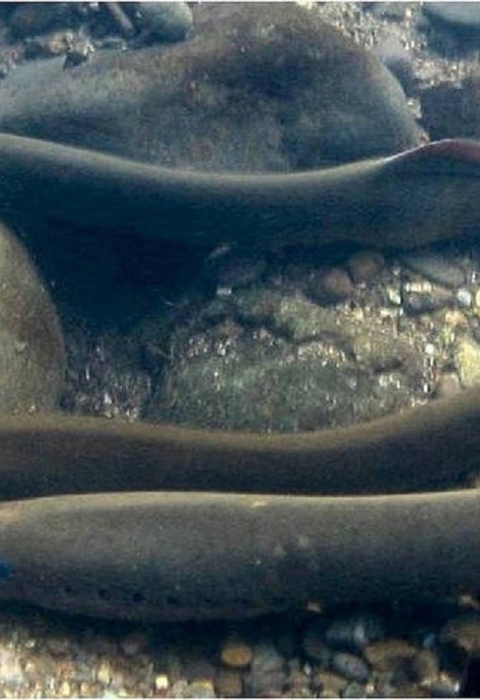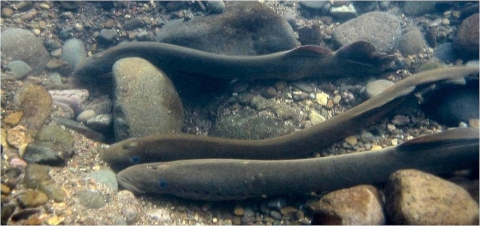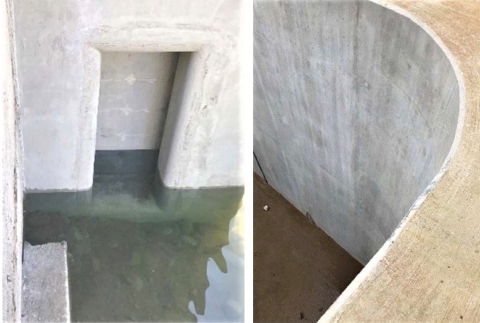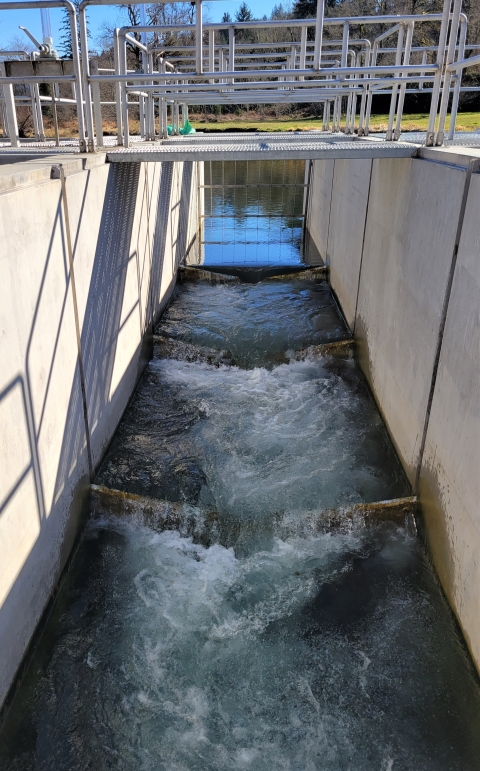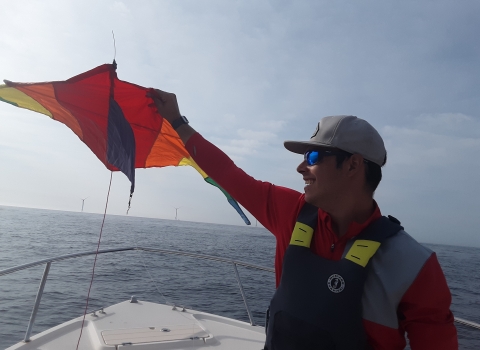By Jan Peterson, for the U.S. Fish and Wildlife Service, Pacific Region
Fish passage restoration projects have historically had a laser-like focus on restoring passage for endangered salmonids such as the threatened coho and sockeye salmon and steelhead.
But a restoration project at Oregon Department of Fish and Wildlife’s Three Rivers-Cedar Creek Hatchery near Oregon’s north coast recently won honors for an innovative design that opens access for all species of fish, including the often overlooked but ecologically and culturally crucial Pacific lamprey. Oregon’s State Land Board — which consists of Governor Kate Brown, Treasurer Tobias Read and Secretary of State Shemia Fagan — announced the award on October 11.
What makes this fish passage fish passage
Fish passage is the ability of fish or other aquatic species to move freely throughout their life to find food, reproduce, and complete their natural migration cycles. Millions of barriers to fish passage across the country are fragmenting habitat and leading to species declines. The U.S. Fish and Wildlife Service's National Fish Passage Program is working to reconnect watersheds to benefit both wildlife and people.
Learn more about fish passage project so different is its awareness of the importance of Pacific lamprey to the overall health of the ecosystem. While not designated as federally threatened, the lamprey’s numbers have diminished significantly in the decades since the area’s fish hatcheries were built. “At Bonneville Dam, there used to be so many lampreys on the counting window, they had a squeegee to wipe off the lampreys. As, well, Willamette Falls would be covered with lampreys queued up to ascend the falls,” says Joe Skalicky, fish biologist and program co-lead for passage and habitat assessment at the U.S. Fish and Wildlife Service’s Columbia River Fish and Wildlife Conservation Office, in Vancouver, Washington.
“The more and more I started looking at lamprey biology and passage, the more I became totally fascinated with lampreys — what we know, but more so, what we don’t know,” Skalicky says. “We often say we’re kind of where we were in the ’70s in salmon research.”
So, what makes Pacific lamprey special? It’s like few other fish. Although they’re sometimes referred to as eels, they’re not. They have no bones, no paired fins, and no scales. When they transform from larvae to juveniles, they grow eyes and grow teeth in a jawless suction mouth and migrate to the ocean. During their ocean life stage, they are a parasite that attaches itself to other fish to feed. Skalicky points out the lampreys aren’t thought to often kill other fish, but just feed and then move on to another host. Instead of swimming like salmon, lampreys sort of wiggle through the water, typically along the base of streams. Rather than jumping, as salmon do, lampreys suction onto surfaces and burst forth to climb up and over falls or other obstacles.
As with other anadromous species, Pacific lamprey begin their lives in fresh water. Ann Gray, a biologist with the Service, says lamprey are important for a number of reasons, including saving the salmon. “To quote Tribal elders: ‘If you want to save the salmon, save the lamprey.’ It’s all about having a complete community of fish and all the connections between the species that are dependent on one another.” Gray says. “They are the earthworms of the river because their larvae live from 4 to 10 years in the sediment, and they filter feed that whole time.”
Skalicky says the calorie content of Pacific lamprey is two or three times higher per unit of body mass than salmon. “All the fish that evolved with them know that, so they specifically target larval and juvenile lamprey. They’re a predation buffer for salmon. They’re essentially a swimming cheeseburger,” he says.
Lampreys have also historically been very good at survival. The fish are believed to have been on Earth for about 400 million years. “They’ve adapted to multiple global catastrophes in the millions of years they’ve been around,” Skalicky says. “They’re older than trees, which is my favorite fact.
“Then along come humans and 90-degree corners.”
Because Pacific lamprey use a burst and attach technique for climbing over obstacles, 90-degree angles present a challenge and often preclude passage altogether.
When project leaders began working on the Three Rivers-Cedar Creek Hatchery Fish Passage Restoration project, they felt it was crucial to keep in mind the unique needs of all species, including lamprey, moving up and down the waterways.
The project removed a channel-spanning weir that was seasonally impeding passage to more than 14 miles of habitat in the Three Rivers system. They removed a 15-foot-wide concrete apron and 3-foot-high stem wall that spanned the full width of the river. They replaced the entire system with an adjustable Obermeyer weir, new fish ladder and a screen to improve access up and down stream for all wild species. When the weir is lowered, unimpeded access is available for all species.
Amy Horstman — National Fish Passage Program coordinator for Oregon and a biologist with the Service’s passage and habitat assessment team at the Columbia River Fish and Conservation Office’s Ecological Services — says this project was a little unusual because it was at an active and functional state fish hatchery.
“It was done in the context of doing full river reconnection, but we had to accommodate fish passage both up and downstream for all species historically present, but in a way that still allowed the hatchery to sort hatchery fish,” Horstman says.
Horstman says the site was a known barrier for a long time and was on both the state priority list and was identified as a priority barrier on the Salmon SuperHwy list. The Salmon SuperHwy is a collaborative project that aims to restore access to more than 180 miles of blocked habitat in Oregon’s north coast area. In its quest to deliver more than 90 projects in 10 years, as of January 2022, it was halfway to its goal, having reconnected more than 115 miles.
Something temporarily or permanently constructed, built, or placed; and constructed of natural or manufactured parts including, but not limited to, a building, shed, cabin, porch, bridge, walkway, stair steps, sign, landing, platform, dock, rack, fence, telecommunication device, antennae, fish cleaning table, satellite dish/mount, or well head.
Learn more about structure that will provide unimpeded access to wild fish.
Horstman says two main accommodations were made for lamprey. “Along the top of the weir, the pieces are curved rather than 90-degree angles so lamprey can climb over the panel using their oral disk to suction across the top. Another accommodation are the cutouts on the bottom corners of the weir, so lampreys moving along the bottom could use burst and suction mode of transportation to move through the ladder uninterrupted,” she says.
Meanwhile, design accommodations were made so that salmon jump into the collection trap for hatchery staff to collect and sort them, but lampreys and smaller fish can swim upstream and avoid the trap.
“These design features use the differences between the way lamprey and salmon move, differences in body size, and their unique abilities to get each where they need to go,” Horstman says, “We really appreciate the Oregon Department of Fish and Wildlife’s efforts to take the best available information on Pacific Lamprey passage needs and fully consider it in this ladder design. It was a great collaboration”.
Joel Watts, fish screening and passage engineer for the Oregon Department of Fish and Wildlife, says the Obermeyer inflatable dam has been around a while but is just gaining popularity. “One of the first ones Oregon Department of Fish and Wildlife used was about 10 years ago on the east fork of the Hood River. That’s a pretty volatile system, so that was a good test location for those. If they can work there, they can work anywhere,” Watts says.
Horstman says she’s hopeful these types of accommodations will be used in more passage projects where artificial structures like ladders are required. “These design features didn’t come without cost, but the costs to include lamprey was pretty minimal compared with the overall project,” she says.
The $2.8 million project was the result of many people from various governmental and nongovernmental agencies working toward a collaborative solution. The Oregon Department of Fish and Wildlife, owner of the hatchery, served as project lead and provided $2.3 million in funding. The U.S. Fish and Wildlife Service provided technical review, permitting assistance and $150,000. The U.S. Forest Service provided $150,000 and technical review. Trout Unlimited provided $200,000 through a Resources Legacy Fund grant. And the Nestucca Neskowin Sand Lake Watersheds Council provided local support during fish salvage.
The U.S. Fish and Wildlife Service and its partners are dedicated to building back better habitats, improving fish passage, and upgrading our infrastructure to make public lands more accessible to all visitors. Through these efforts we provide jobs and help support community resilience for the millions of Americans who both depend on and enjoy on our public lands.
Read more about the project’s Oregon State Land Board Award here: Columbia River Fish and Wildlife Conservation Office’s National Fish Passage Program Project Receives State Land Board Award
